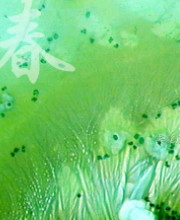| 图片: | |
|---|---|
| 名称: | |
| 描述: | |
- 盆腹腔巨大囊实性肿物
-
normal tissues:
-
cortical thymocytes: medullary thymocytes are usually negative
-
mature peripheral T and B cells are usually negative
-
pancreatic islet cells
-
urothelium
-
some squamous cells
-
columnar epithelial cells
-
fibroblasts
-
endothelial cells2
-
granulosa/Sertoli cells
-
-
T-cell ALL: one T-cell acute lymphoblastic leukaemia6 and seven of 11 T-lymphoblastic lymphomas6. All 8 B-lymphoblastic lymphomas were negative6. Positivity correlates with positivity for TdT7.
-
Ewing's sarcoma / PNETs: 13 of 15 Ewing's sarcomas and 14 of 15 PNETS 6
-
islet cell tumours
-
carcinoids
-
rhabdomyosarcoma: 4 of 14 embryonal rhabdomyosarcomas using 12E76 . All 10 alveolar rhabdomyosarcomas were negative6.
-
nephroblastoma
-
leiomyosarcoma: 6 of 47 cases1
-
synovial sarcomas: 41 of 85 cases1
-
haemangiopericytomas: 21 of 33 cases1
-
malignant fibrous histiocytoma: 9 of 24 cases1
-
mesenchymal chondrosarcoma
-
rarely mesotheliomas: 1 of 10 cases1
-
uterine tumours with sex cord differentiation (1/23, 7/74)
-
Leydig cell tumour of testis and occasional Sertoli cell tumour of testis
-
Identification of immature lymphocytes in the diagnosis of thymoma
-
PNET / Ewing's sarcoma
cd99 is a 30-32 kD cell surface glycoprotein encoded by a pseudoautosomal gene located on the X and Y chromosomes. It is expressed by a range of high grade malignancies.
Antibodies are effective on paraffin-embedded tissue5.
Immunohistochemical expression
Positivity takes the form of strong membrane staining.
Diagnostic utility
CD 56
|
Leiomyoma |
18/2112 |
|
26/3412 |
-
pathologybz 离线
- 帖子:14
- 粉蓝豆:2
- 经验:20
- 注册时间:2012-02-28
- 加关注 | 发消息
-
pathologybz 离线
- 帖子:14
- 粉蓝豆:2
- 经验:20
- 注册时间:2012-02-28
- 加关注 | 发消息
-
pathologybz 离线
- 帖子:14
- 粉蓝豆:2
- 经验:20
- 注册时间:2012-02-28
- 加关注 | 发消息
本例从大体形态、组织学和免疫表型看,首先还是应该考虑卵巢纤维瘤、卵泡膜纤维瘤或富于细胞性纤维瘤,具体哪个要看组织切片决定。
理由如下:
1、大体上囊实性,这是卵巢纤维瘤或卵泡膜纤维瘤常见的表现。
2、组织学由一致的梭形细胞构成,间质有水肿、粘液样变,略呈结节状改变。据楼主的观察核分裂少见。
3、免疫组化表达desmin、CD56、Vimentin、CD99,这些与假设诊断并不矛盾。
Inhibin expression in ovarian tumors and tumor-like lesions: an immunohistochemical study.
Source
Department of Pathology, University of Mainz, Germany.
Abstract
We investigated 203 ovarian tumors and tumor-like lesions for inhibin expression using a monoclonal anti-inhibin alpha antibody. Inhibin was present in the tumor cells in all 14 primary adult granulosa cell tumors (4 luteinized) plus 3 metastatic, all 10 primary juvenile granulosa cell tumors plus 1 metastatic, 10 of 11 thecomas, 3 of 11 fibromas, 4 of 11 sclerosing stromal tumors, 6 of 11 Sertoli cell tumors (1 oxyphilic), 7 of 11 Sertoli-Leydig cell tumors, 1 gynandroblastoma, 10 primary ovarian sex cord tumors with annular tubules plus 2 metastatic, 8 of 9 steroid cell tumors, both pregnancy luteomas, 1 of 2 unclassified sex cord tumors, 2 of 5 gonadoblastomas, 9 of 10 female adnexal tumors of probable wolffian origin, and in the non-neoplastic stroma of many carcinomas and germ cell tumors. The tumor cells were inhibin-negative in 10 fibrosarcomas, 12 small cell carcinomas of hypercalcemic type, 24 germ cell tumors (except for a focus of inhibin-positive syncytiotrophoblast in one case), and 17 ovarian carcinomas. Two of the three inhibin-positive fibromas showed diffuse immunostaining and were associated with evidence of estrogenic activity. Among nine Sertoli-Leydig cell tumors with available clinical data, four that were more than minimally inhibin-positive were accompanied by androgenic manifestations; five inhibin-negative or only minimally positive tumors lacked such evidence. Inhibin immunostaining may be useful in the differential diagnosis of inhibin-positive sex cord tumors versus histologically similar inhibin-negative neoplasms, but inhibin negativity does not preclude a diagnosis of sex cord tumor. The unexpected, common inhibin positivity of female adnexal tumors of probable wolffian origin indicates that inhibin staining cannot be used to differentiate these tumors from Sertoli cell tumors. Inhibin immunostaining is also helpful in identifying potential steroid hormone-secreting cells in the non-neoplastic stromal component of epithelial, germ cell, and other ovarian tumors.
Expression of CD56 and WT1 in ovarian stroma and ovarian stromal tumors.
Source
Division of Pathology, City of Hope National Medical Center, Los Angeles, CA, USA.
Abstract
The immunophenotype of ovarian stroma and spindle cell tumors derived from ovarian stroma has not been well studied. We studied the expression of CD56, WT1, estrogen receptor-beta (ER-beta), progesterone receptor (PR), smooth muscle actin, S-100, CD34, and muscle specific actin in 16 normal ovaries, 17 ovarian fibromas, 11 ovarian cellular fibromas, 10 ovarian fibrothecomas, and 11 ovarian leiomyomas. In addition, we studied CD56 and WT1 expression in 7 cases of normal endometrium, 8 uterine smooth muscle tumors, 5 endometrial stromal tumors and 64 nongynecologic (GYN) spindle cell sarcomas. All normal ovaries, ovarian fibromas, fibrothecomas, and ovarian leiomyomas were positive for CD56 and WT1. Most of the normal ovaries, ovarian fibromas, ovarian fibrothecomas, and ovarian leiomyomata also expressed ER-beta and PR. Eight of 17 ovarian fibromas, 5 of 11 ovarian cellular fibromas, and 4 of 10 ovarian fibrothecoma with focal fibroblastic differentiation were positive for smooth muscle actin. A few cases of these tumors also expressed S-100 and CD34. Only rare cases of non-GYN spindle cell sarcomas expressed WT1. Our study results show that ovarian fibromas, fibrothecomas, and leiomyomas have a similar immunophenotype (positive for CD56, WT1, ER-beta, and PR) to that of ovarian stromal cells, supporting an ovarian stromal origin for these neoplasms. However, unlike normal ovarian stromal cells, ovarian fibromas, fibrothecomas, and leiomyomas can also show fibroblastic, smooth muscle, Schwannian, and solitary fibrous tumorlike differentiation. WT1 is a fairly specific marker for spindle cell tumors of gynecologic organs, including ovarian spindle cell tumors, endometrial stromal tumors, and uterine smooth muscle tumors. Non-GYN spindle cell sarcomas rarely express WT1. CD56 is strongly expressed in ovarian stromal cells but not in endometrial stromal cells. CD56 is often expressed by a wide variety of spindle cell sarcomas, thus, it has no value in differentiating GYN from non-GYN spindle cell tumors.
Immunohistochemical analysis for desmin in normal and neoplastic ovarian stromal tissue.
Source
Department of Pathology, Columbia Presbyterian Medical Center, New York, NY 10032.
Abstract
Ovarian stroma contains cells with the ultrastructural features of smooth-muscle cells. The purpose of this study was to analyze normal ovaries, ovarian stromal tumors (fibroma/thecomata and granulosa cell tumors), and ovarian leiomyomata for desmin reactivity. Groups of ovarian stromal cells that expressed desmin were noted in six of six normal ovaries. Desmin was also detected in two of six fibroma/thecomata and two of two ovarian leiomyomata. The number of tumor cells with detectable desmin was much greater in the leiomyomata. Desmin was not detected in any of six granulosa cell tumors. We conclude that stromal cells with an immunohistochemical feature of smooth-muscle cells are routinely found in normal ovaries. This study demonstrates the usefulness of immunohistochemistry in corroborating the diagnosis of ovarian leiomyomata, although desmin positivity per se is not diagnostic of ovarian leiomyomata, and also raises the possibility that some ovarian leiomyomata may be derived from stromal cells.
-
本帖最后由 Renghis 于 2012-03-18 09:52:05 编辑
中山大学附属肿瘤医院 会诊结果:
混合性子宫内膜间质-平滑肌肿瘤(低级别,低度恶性)。
本例纯粹被免疫组化坑了!
我院免疫组化SMA和CD10完全阴性,可在会诊医院却显示阳性,会诊医院加做HHF35也是阳性(SMA、CD10及HHF35阳性范围及强度不清楚)。由此认为,HE形态学还是放在第一位,当HE形态强烈怀疑某个肿瘤,而关键免疫组化不支持时,这时就要好好思索是不是免疫组化的问题了,可以加做对照或使用外院抗体。

名称:图1
描述:P1020687

- 重归学生时代!
-
emilypeaker 离线
- 帖子:654
- 粉蓝豆:1570
- 经验:2182
- 注册时间:2011-01-03
- 加关注 | 发消息
































































